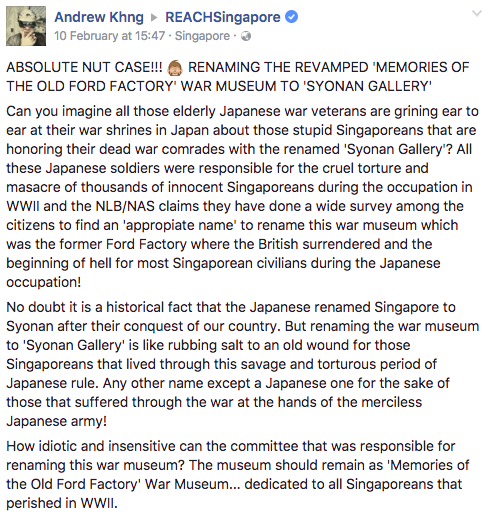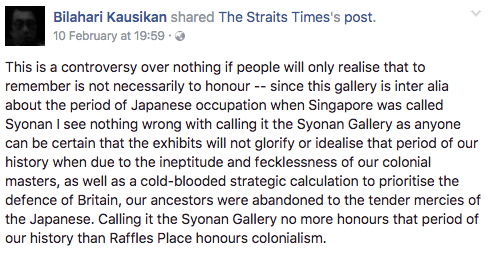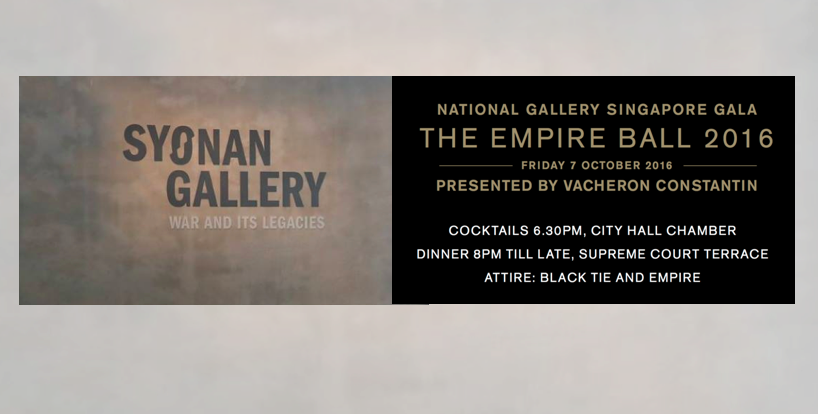The National Library Board's (NLB) choice of name for the newly-revamped museum at the former Ford Factory in Upper Bukit Timah road has stirred up some strong sentiments among Singaporeans lately.
Calling it the Syonan Gallery: War and Its Legacies, the new museum, which is housed on the site of the British surrender to Japanese forces on Feb. 15, 1942, takes its name from what Singapore was called during the Japanese Occupation (1942 to 1945) - Syonan-To, meaning "Light of the South" in Japanese.
Those who are against the museum's name have pointed out that it is offensive to those who had lived through the war, and that the name inappropriately honours the brutality of the Japanese Occupation.


However, some say that the name is appropriate, for it serves as reminder for Singaporeans on the need to protect and defend their country, contrary to honouring Japanese brutality.


On its choice of name, NLB said in a Straits Times report on Feb. 10 that it had decided on the name after consulting historians and its advisory panel. It said that "no other name captured the time and all that it stood for". It also said that it was aware that the name "could evoke strong emotions".
Of Syonan Gallery and the Empire Ball
The latest controversy and debate over the appropriateness of a public name brings to mind a similar incident about five months ago.
In September last year, controversy emerged over the National Gallery Singapore's naming of its first fundraising gala The Empire Ball 2016. The event was organised to coincide with the opening of the Gallery's international exhibition, Artist and Empire, showcasing art from the British Empire.
[caption id="" align="aligncenter" width="760"] Source: The National Gallery Singapore’s Gallery Guide (July – September 16 issue) [/caption]
Source: The National Gallery Singapore’s Gallery Guide (July – September 16 issue) [/caption]
The Gallery was criticised, especially by the arts community, for glorifying colonialism and the British Empire in its choice of name for its gala. As a result, the Gallery renamed the event to the National Gallery Singapore Gala.
A strengthening Singaporean identity?
While both incidents have different contexts - the Syonan Gallery is a sombre museum dedicated to educating and remembering the dark period of the Japanese Occupation in Singapore, and the Empire Ball involved a gala event that was more celebratory in nature - their controversial choice of names relate to aspects of Singapore's past that evoked a sense of Singapore identity.
A common history and heritage are among the key ingredients in the construction and strengthening of national identity. The narratives of Colonialism and the Japanese Occupation are important parts of the common history that Singaporeans share and build our national identities on.
Thus, the outcries and debates over the Syonan Gallery and Empire Ball suggest an increasing consciousness of Singapore's history and heritage, and that can be taken as a sign of a strengthening Singaporean identity.
This should not come as surprise, as Singaporeans respond to a globalised environment.
Amidst the presence of the world in their backyard, Singaporeans are driven to strengthen their own identity, perhaps out of fear of its dilution or loss. One way of doing so is by holding on to history, and drawing on the lessons and experiences of the past.
There may be also other present day issues that might be driving Singaporeans to be more conscious of the lessons and experiences from history.
The historical narratives of Colonialism and the Japanese Occupation tell of bigger powers controlling Singapore and bullying Singaporeans into submission. Perhaps, when Singaporeans get cautious over the danger of honouring or glorifying Singapore's colonial history and Japanese Occupation, they are also unconsciously sending a message out to the bigger powers of today, that they will not be subject to the same treatment experienced in the past.
Beware the dangers of overzealous political correctness
As we become more conscious of history and strengthen our national identity in the process, we also need to be mindful of the pitfalls of overzealous political correctness.
In the case of the Syonan Gallery, which is essentially a museum dedicated to educating and remembering the dark period of the Japanese Occupation in Singapore, the name by no means honour the atrocities and brutality of the Japanese Occupation. Instead, it serves as a stark reminder of Singapore's vulnerabilities, and the need for us not to take our security and defence for granted.
To highlight this point, we can look to museums overseas for examples on the naming of museums, such as the United States Holocaust Memorial Museum, the House of Terror Museum (TERROR HÁZA MÚZEUM) in Hungary, and Nanjing Massacre Memorial Hall. Auschwitz-Birkenau, the feared name and location which saw 1.1 million Jews murdered in the Holocaust, has also had its name retained to this day for the world to remember the atrocities committed there, rather than honouring the heinous acts by the Nazis.
Hence, while there may be scope to review the appropriateness of the naming of "Syonan Gallery", taking into account the feedback of older generations who lived through that period, we should also be mindful of overzealous political correctness.
By swinging to the extreme of political correctness, the name of Japanese-occupied Singapore may one day be erased from our history and memories altogether, along with reminders of our colonial past, such as Raffles Place, Shenton Way, and Clementi.
Top image from NLB Facebook and the National Gallery Singapore’s Gallery Guide (July – September 16 issue).
If you like what you read, follow us on Facebook and Twitter to get the latest updates.
If you like what you read, follow us on Facebook, Instagram, Twitter and Telegram to get the latest updates.
